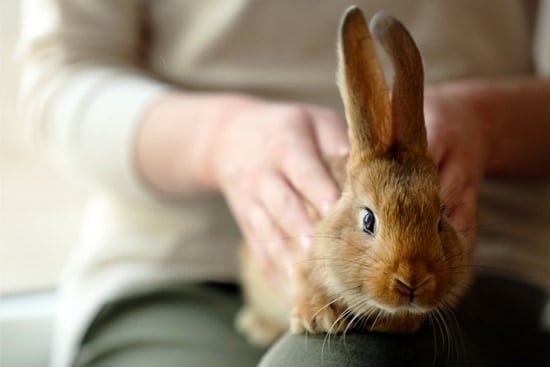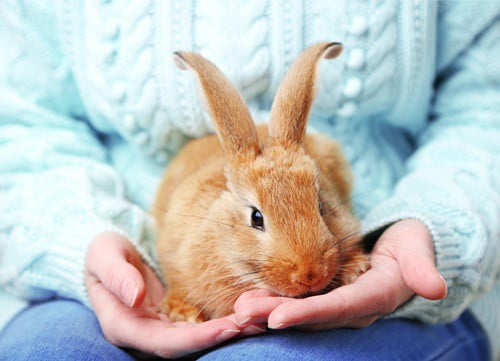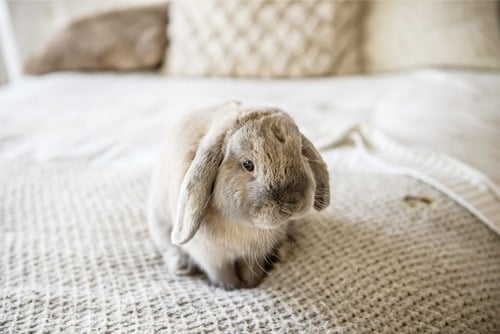Determining if a rabbit is sick isn’t always easy, so we look for sudden temperature changes. Naturally, a rabbit with cold ears is likely to be a source of concern. In the wild, rabbits are at the bottom of the food chain, and are innately predisposed to hide their injuries and illnesses.
Rabbits regulate their body temperature via their ears. A rabbit’s ears can feel cool or cold to touch when it’s warming its body. This is especially common in the winter or during windy conditions.
Cold ears in rabbits can indicate an illness, when combined with other symptoms, such as lethargy and loss of appetite. Very cold ears indicate a drop in body temperature. When coupled with other warning signs, cold ears could warrant a trip to the vet. On its own, it’s rarely a cause for concern.
Why Are My Rabbit’s Ears So Cold?
Rabbits adapt to the cold primarily by reducing heat loss from their skin. Rabbits don’t respond to cold weather through shivering. Their temperature regulation takes place through their ears. In the cold, a rabbit will curl up and lower its ear temperature to prevent heat loss from its body.
Temperature Regulation in Rabbits
According to Michigan State University, a rabbit’s normal body temperature is 102 to 103 degrees Fahrenheit. The outside temperature at which a rabbit can process its food most efficiently and gain weight easily (its comfort zone) is at 60 to 65 degrees F.
During cold weather, rabbits have their own ways of coping with the cold, which include:
- Ears. Rabbits produce heat from all parts of their body. However, there is a significant network of blood vessels that accumulates the region around the ears where higher thermic exchanges take place. When a rabbit is too cold, it can conserve its body heat by cooling its ears and preventing heat transfer to the environment.
- Breathing. Nearly 80% of the heat produced by a rabbit occurs via the evaporation of water during breathing. Rabbits respond to cold weather by lowering their breathing pace. This helps them trap body heat.
- Behavior. When temperatures are below 50 degrees F, rabbits often curl up, minimizing the total body area exposed to the environment. This allows them to reduce thermic exchanges between the skin and ambient air.
Are Rabbit Ears Supposed To Be Cold?
It is normal for rabbit ears to be cold when the surrounding air is much lower than their core temperature. Rabbit ears function similarly to car radiators, according to the Food and Agriculture of the United Nations. A rabbit controls its core temperature by managing the blood circulation from the body to the blood vessels in the ear lobe.
According to the American Journal of Anatomy, a rabbit’s ear lobes are supplied with an extensive meshwork of blood capillaries that can be contracted or dilated (a vasomotor mechanism). When the body temperature drops, the blood vessels in the ears contract and reduce blood flow to the ears.
Rabbits have large ears with a little fur on the outside and almost no fur on the inside. Rabbits are more tolerant of the winter than they are to heat. During hot weather, the size of the ears combined with the lack of fur allows body heat to escape more easily.
During the winter, rabbits fold their ear pinnae to cut away the internal surface’s exposure to the surrounding air. At the same time, they’ll also bring their ears closer to the body, reducing heat loss via convection, radiation, and evaporation.
When the ear temperature is less than the surrounding temperature, it allows the rabbit to absorb heat and maintain its core temperature to 102 to 103 degrees F.

When Are Cold Rabbit Ears A Cause For Concern?
A sick rabbit may have cold ears, along with other symptoms. Cold ears on its own, however, are rarely a cause for concern.
Like most animals, rabbits get sick for many reasons. Exposure to germs, consuming something that may cause an adverse reaction and being genetically predisposed to a condition are all common causes of illnesses in rabbits.
Being at the lower end of the food chain, rabbits tend to hide signs of illness. Showing weakness puts them at risk of being hunted by a predator. Domestic rabbits do not have this risk, but their reluctance to show signs of an illness can mislead pet owners and prevent them from seeking immediate medical attention when needed.
This is why keeping a lookout for subtle signs, including physical and behavioral changes is so critical while taking care of rabbits. If your rabbit has cold ears, check if it is showing any other sign of being sick. The following table explains how to detect signs that may indicate that your rabbit is ill.
Rabbit’s Ears Are Cold After Being Spayed
Anesthesia often causes an animal’s body temperature to drop. The American Animal Hospital Association (AAHA) requires accredited veterinary hospitals to monitor the core temperature of an animal during anesthesia and recovery. In most animal hospitals, pet patients are kept warm using heating elements throughout surgery to prevent them from getting hypothermia.
It is normal for a rabbit to feel cold following surgery. Keeping your rabbit warm, especially after it has been spayed, is extremely important.
Although rabbit ears aren’t the best indication of body temperature, if your pet’s ears feel very cold, it means its core temperature is low. A core temperature that is too low can lead to hypothermia and may even be life-threatening.
How To Check Your Rabbit’s Temperature
A rabbit’s normal body temperature lies between 102 to 103 degrees F. It is important to keep in mind that you should not take your pet’s temperature more often than what’s necessary. Taking a rabbit’s temperature can be stressful for the animal and may even make its condition worse.
If you do not know how to take your rabbit’s rectal temperature, it’s best to allow your vet to show you how to do it before you meet with an emergency. Always use a rubber-tip thermometer to eliminate the risk of the thermometer breaking off inside your pet if it reacts with a strong wiggle or kick. To take your rabbit’s temperature, follow these steps:
- Start by cradling your rabbit on its back, either on a secure countertop with comfortable padding or on your lap.
- Hold the rabbit’s head and shoulder gently against your abdomen. Its back should be curled into a “C” formation. Footpads must face the ceiling. This position keeps the path of the rectum almost parallel to the lower spine, allowing the thermometer to travel straight down more naturally.
- Secure and support your rabbit’s back legs so that it doesn’t kick and injure itself.
- Once your rabbit is calm, very carefully insert a rubber-tip thermometer that has been well-lubricated. Never go deeper than 1 inch. Keep in mind that the anus will wink back at you when you touch it gently with the thermometer tip. The anus is also behind the urogenital opening, which is closer to the base of the tail.
Don’t Stress Your Pet
Make sure you support your rabbit’s back end securely, preventing it from struggling or kicking. If your rabbit does struggle, carefully release it on its belly position, supporting its hindquarters and back at all times. Continue talking reassuringly to your rabbit and pet it gently. Try again when it calms down. Avoid stressing your rabbit if it continues to struggle and take it to a vet instead.
Never force anything. If you feel resistance, pull back and change the position before trying again. Always be gentle as a rabbit’s rectum and colon are incredibly delicate and can easily be damaged.
Considerations
Many argue that the standard method of placing a rabbit on its back while taking its temperature can cause more harm than good. For example, if your rabbit is in shock, due to poor circulation, placing it on its back may be life-threatening. If you are worried that you may harm your pet while taking its temperature, it’s always best to leave this step to a veterinarian.
Feeling your rabbit’s ears is a safe way to gauge if everything is alright. Rabbit ears that are too cold or too warm can be a sign of something serious, if other symptoms accompany them.
Rabbit ears aren’t an accurate measure of a rabbit’s internal temperature, but keeping an eye out for other possible signs can help you determine whether you need to see a vet.
Another technique is to place your rabbit in a burrito using a small blanket or towel. Leave the back end hanging out and the legs tucked inside. Keeping your rabbit’s bottom just over the edge of a table will allow you to take its temperature from underneath.
For this method, it’s best to have another person help you so that one person can restrain the rabbit, while the other takes the temperature.
My Rabbit Has Cold Ears And Isn’t Eating
Rabbits tend to chew on or eat anything they can get their teeth into. Therefore, unlike in the case of cats or dogs, a rabbit’s refusal to it is a significant cause for concern and could indicate a medical emergency. Call your vet immediately if your rabbit’s ears are cold and if it refuses to eat.
The most common cause of loss of appetite in rabbits is a gastrointestinal condition called ileus. The problem occurs when the normal contractions that arise inside a rabbit’s intestines to push food through the digestive tract reduce or stop. Ileus is a fatal condition in rabbits that can be life-threatening if left untreated.

Causes Of Ileus In Rabbits
Ileus often occurs as a result of an underlying problem. Some reasons include:
- Overgrown teeth
- Dental disease
- Abscesses inside or around the rabbit’s body
- Neurological diseases, such as E. cuniculi
- Intestinal parasites
- External parasites, such as fleas or lice
- Hock sores and bumblefoot
- Gastric ulcers
- Osteoarthritis
- Stress and environmental changes
- Organ failure or organ disease
- Respiratory diseases
- Toxins and poisoning
- Tumors
- Infectious diseases
Ileus Signs and Symptoms
If your rabbit has a loss of appetite, look out for the following signs of ileus:
- Overgrown incisors (front teeth). You can check this easily by lifting your rabbit’s lips.
- Tumors and abscesses. Stroke your rabbit and see if you can find a lump.
- Eye or nasal drainage. This is easily noticeable if it isn’t normally present. You may notice your pet constantly wiping its face with its front paws. This may also result in soiled front legs from nasal drainage.
You can also check if your rabbit’s nasal passages are clear and create condensation by placing a mirror up to its nose.
Sometimes it isn’t easy to spot changes in your rabbit’s appetite. It may not be as clear cut as your rabbit leaving its food untouched. If you aren’t sure if your rabbit is eating normally, look out for the following signs:
- Changes in the texture of feces. Feces may be watery, hard, sticky, etc.
- A decrease in poop in the litter box or no poop at all
- Smaller feces
- Weight loss (you can monitor your rabbit’s weight using a baby scale)
- Refusal to eat its favorite treat
- Teeth grinding (bruxism)
- A decrease in activity level, or lethargy
- Increase in food that is left uneaten
Homecare
If signs of ileus aren’t obvious, think about any environmental changes that may have caused stress in your rabbit. Reverse these changes and offer your rabbit its favorite treat or some food.
Consider using home remedies only if your rabbit hasn’t eaten for just a few hours. If your rabbit hasn’t eaten for even one day, it’s likely that your pet is in a life-threatening situation and needs immediate veterinary attention.
Even when you are trying to treat your pet at home, make sure you call your vet and consult with them without any delay. Homecare for ileus in rabbits includes the following steps:
- Mixed veggie baby food. You’ll have to force-feed your rabbit with a syringe to stimulate its gastrointestinal tract. Not eating for prolonged periods can cause gas to fill up in your rabbit’s intestines due to lack of or absence of normal peristalsis. This can cause intense pain.
- Exercise and massage. Once you’ve force-fed your rabbit, encourage it to exercise. Massage its belly to stimulate mobility in the gastrointestinal tract muscles.
- Increased hydration. Increase your rabbit’s water intake by filling a clean water bowl and a water bottle for it to drink from. You can also feed your rabbit more water through a syringe or by offering it wet vegetables. An electrolyte solution, such as unflavored Pedialyte, may also help your pet eliminate normally.
- Diet. If your rabbit eats even a little bit, make sure the greens provided have higher water content. Lettuce and celery are excellent options. Combine this with high-quality hay and avoid feeding any pellets until your pet gets better.
If your rabbit continues to refuse its food, call the vet immediately.
Diagnosis and Treatment
Your vet may recommend IV fluids or other forms of hydration to get something immediately into your rabbit’s body. This will be accompanied by pain medication, as well as medication to alleviate gas production and gastric mobility.
Your vet will also force-feed your rabbit with veterinary-grade products, such as Emerald Intensive Care Herbivore and Oxbrow Critical Care. This will provide your rabbit with the nutrition it needs to carry out its normal bodily functions and get healthy again.
During the treatment process, your vet will also determine the cause for your rabbit’s refusal to eat. This isn’t easy as there are several causes for loss of appetite in rabbits, and many tests are required during diagnosis. In addition to a physical exam, your vet may recommend blood tests, urine tests, fecal tests, a dental examination, X-rays, and other tests, as needed.
Aggressive treatment with fluids and medication may be needed if testing is limited. This may be due to financial constraints or a rabbit’s poor health. Furthermore, your rabbit’s loss of appetite may recur depending on the underlying cause.
How to Prevent Loss of Appetite in Rabbits
Many diseases that cause loss of appetite in rabbits are preventable. All that is needed is good care. For example, abscessed or overgrown teeth can be prevented with proper dental care. Keeping your rabbit’s cage clean can prevent parasitic infections that cause loss of appetite.
Promoting a healthy appetite in rabbits is easy. Just make sure your rabbit has access to unlimited fresh drinking water, grass hays, and leafy greens. A stress-free environment without fluctuating temperatures and other external stressors can also beneficial.

